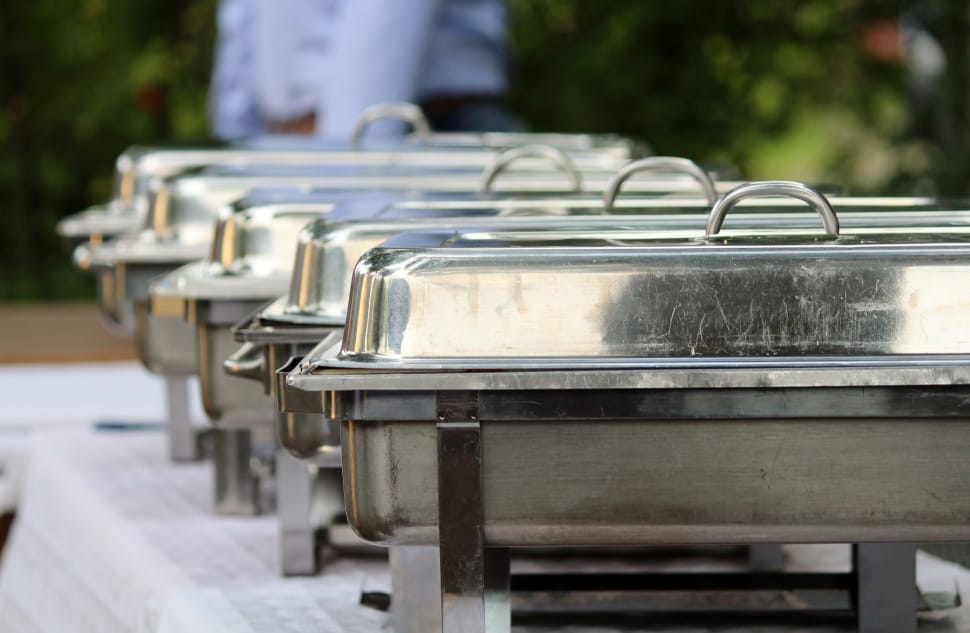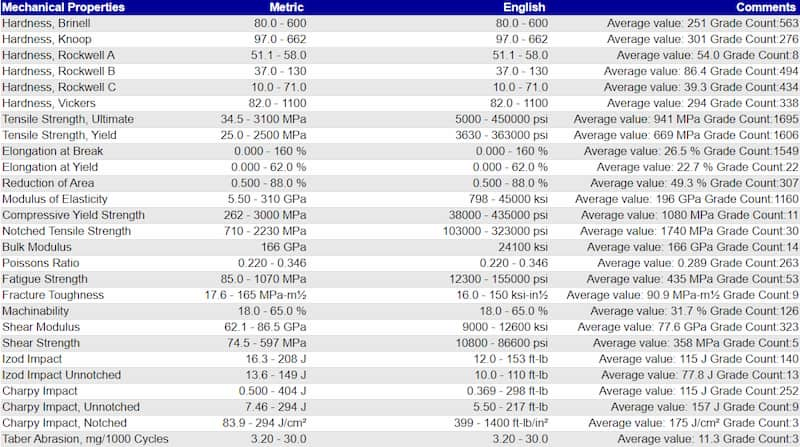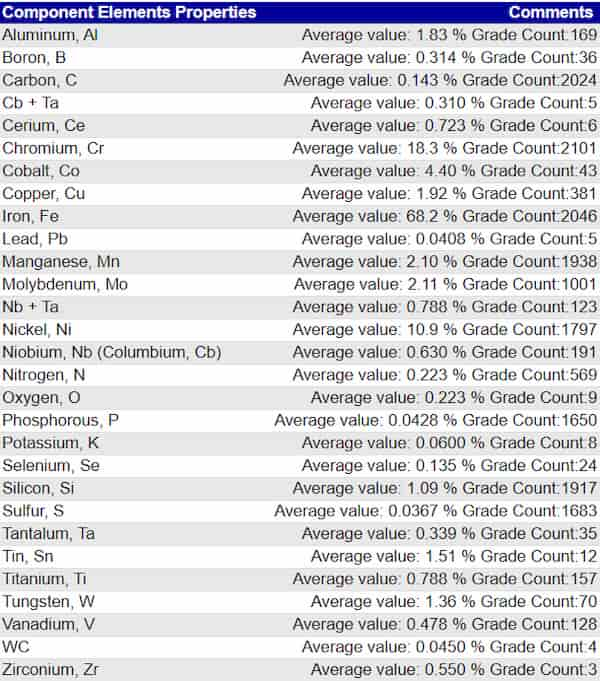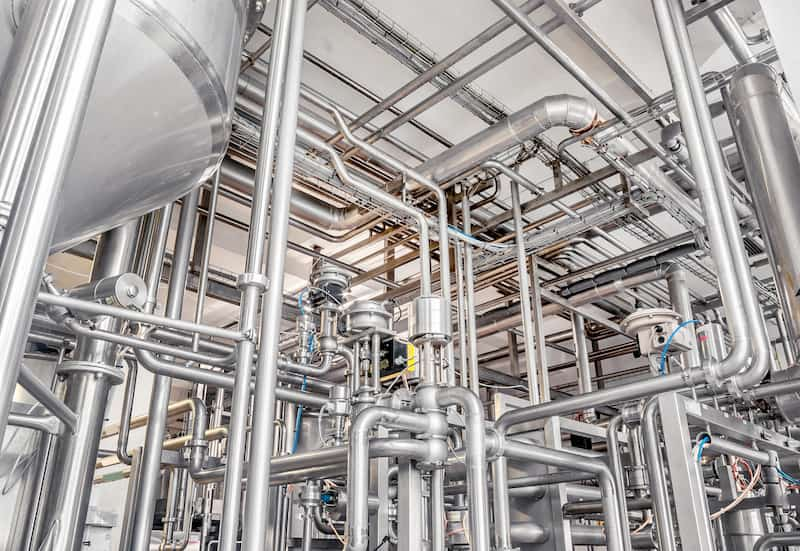The demand for stainless steel is increasing at a whopping 5% each year. In 2019, its global production reached over 52 million tons.
At present, a wide number of industries utilise stainless steel. Aside from traditional and marine constructions, household appliances are also experiencing a rise in usage.
While stainless steel is more expensive than mild steel, its excellent properties lead to increased service life and reduced cycle cost. So the larger upfront costs pay off in the longer run.
This article will take a closer look at this metal and what makes it so popular in different industries.
What is Stainless Steel?
We know that steel is an alloy of iron and carbon with a maximum carbon content of 2.1%. Stainless steels are a group of steels that are resistant to corrosion through the addition of alloying elements.
The term stainless steel is used to describe a family of about 200 alloys of steel with remarkable heat and corrosion resistance properties. The carbon percentage can range from 0.03% to 1.2%.
Its distinguishing characteristic is the high amount of chromium. Stainless steel contains a minimum of 10.5% of chromium that improves its corrosion resistance and strength.
The chromium in the alloy creates a passive layer on oxidation when exposed to air. This layer acts as a shield against further corrosion essentially making the alloy rustproof. This mechanism allows for retaining a spotless appearance for long periods under normal working conditions.
Benefits of Stainless Steel
Stainless steel has been used with phenomenal success in various industries for over 70 years. More applications are being discovered with every passing year as its advantages become more widely identified.
With an increase in demand, production has increased making it more affordable than ever. Increased demand results in availability in standard as well as non-standard sizes. Also, a wide range of stainless steel finishes is available for choosing.
Besides polished finishes, a whole range of patterned and coloured surfaces are available. This makes finding a suitable option for your needs possible.
Stainless steel is also 100 per cent recyclable. In fact, half of all stainless steel production is from scrap metal. This makes it a relatively eco-friendly material.
Use-Cases
Stainless steel is an exceedingly versatile material. It is preferred where the properties of steel and corrosion resistance are required in tandem.
Its first use was in cutlery but due to its corrosion resistance properties. Next, it found its way to the chemical industry. Today, we can see stainless steel pretty much everywhere.
The use cases vary from industry to industry. For example, the uses include making minuscule parts for wristwatches. At the same time, large panels with a certain surface finish may cover whole buildings.

A few industries that use stainless steel extensively:
- Food and catering
- Chemicals and pharmaceuticals
- Medical equipment manufacturing
- Architecture and construction
- Home appliances
- Offshore and shipbuilding
- Automotive manufacturing
- Energy and industry
Types of Stainless Steel
There are many grades and surface finishes of stainless steel available depending on the environment the metal is expected to withstand. Based on the microstructure, they can be classified into four major categories.
Austenitic stainless steel
Austenitic stainless steel has austenite as the primary microstructure. Austenite is a solid solution of iron and carbon that comes into existence above the critical temperature of 723°C. This family of stainless steels displays high toughness and impressive resistance to elevated temperatures.
70 per cent of all stainless steel is austenitic. It contains at least 16% chromium and 6% nickel.
Austenitic stabilisers are elements that are added to prompt the formation of austenite microstructure. This stainless steel grade is a non-magnetic metal and unable to be hardened by heat treatment. Corrosion resistance can be modified depending on the service environment.
- Personal account manager
- Quality assurance
- Payment terms for companies
- On-time delivery by Fractory
Ferritic stainless steel
Ferritic steels will usually only have chromium as an alloying element. The chromium content ranges from 10.5 to 18%. They have average corrosion resistance and poor fabrication characteristics. Heat treatment methods do not help with hardening the metal either.
They generally have better engineering abilities than austenitic grades. Unlike austenitic grades, they are magnetic. They also have good resistance to stress corrosion, resulting in lower corrosive material wear.
Duplex stainless steel
Duplex is a mixture of austenitic and ferritic stainless steel. Thus, it has the properties of both its constituents. It has high chromium and low nickel concentration. With high tensile strength and good weldability, duplex stainless steels offer unique advantages.
It shows good resistance to stress corrosion but not as much as ferritic grades. It is tougher than ferritic grades but lower than that of austenitic grades.
Martensitic stainless steel
This type of stainless steel consists of high carbon and lower chromium content. Like ferritic grades, it is magnetic. It does display poor weldability compared to other grades but it has higher hardenability and can be heat treated to improve properties.
Martensitic stainless steel will have lower corrosion resistance when compared with austenitic and ferritic grades with the same chromium and alloy content.
Precipitation hardening stainless steels
This sub-group provides a combination of austenitic and martensitic properties. Hardening is achieved by adding one or more elements such as aluminium, molybdenum, niobium, titanium, and copper.
It is capable of developing high tensile strength through heat treatment. It contains chromium and nickel as alloying elements. These grades are used in high-speed applications such as turbine blades.
Grades of Stainless Steel
There are hundreds of grades of stainless steel in the market today. Choosing the right one for your application is important as their properties can be quite different from each other.
The AISI (American Iron and Steel Institute) system for naming stainless steel is still used by the industry. The numbering system uses three-digit numbers starting with 2, 3 or 4.
200 series
This series is used for austenitic grades that contain manganese. These chromium manganese steels have a low nickel content (below 5 per cent).
200 series find use in:
- Washing machines
- Cutlery
- Food & drinks equipment
- Automotive industry
- In-doors equipment, etc.
300 series
This series is used to name austenitic stainless steels with carbon, nickel, and molybdenum as alloying elements. The addition of molybdenum improves corrosion resistance in acidic environments while nickel improves ductility.
AISI 304 and 316 are the most common grades in this series. AISI 304 is also commonly known as 18/8 steel as it contains 18% chromium and 8% nickel.

300 series stainless steel applications include:
- Food & beverage industry
- Automotive industry
- Structural for critical environments
- Medical instruments
- Jewellery, etc.
400 series
Ferritic and martensitic alloys form this series of stainless steel. These grades are available for heat treating. Providing a good combination of strength and high wear resistance. The corrosion-resistance properties are lower than 300 series, though.
Applications for 400 series include:
- Agricultural equipment
- Motor shafts
- Gas turbine parts, etc.
SAE grades
The SAE system of numbering uses a 1-letter + 5-digit UNS number code to designate stainless steel. The common AISI grade 304 has S30400 as its SAE designation. While most grades have a designation, newly developed exclusive grades may be named by their owners and not have any SAE code.
Stainless Steel Mechanical Properties
If you are unsure what the discussed properties below mean, you can check our overview of material properties to see a longer explanation of each.

Yield strength
Depending on the grade, stainless may exhibit high strength and low elongation or low strength and high elongation properties. They compare very well to carbon steels when it comes to yield strength.
Strength at high temperatures
Stainless steel performs comparatively better than other carbon steels at higher temperatures. It shows better fire resistance due to its high strength retention factor at elevated temperatures (above 500°C). It also has better stiffness retention factor than carbon steel above 300°C.
Tensile strength
When it comes to tensile strength, stainless steel is superior to materials like aluminium, brass, and mild steel.
The highest tensile strength is seen in precipitation hardening and martensitic grades. These grades can have tensile strengths that are twice as much as the ubiquitous 304 and 316 grades. Duplex steel, in particular, has a high strength/ductility ratio.
Cryogenic resistance
Some stainless steel grades are extremely adept at handling a wider range of temperatures. Austenitic steels display exceptional toughness and increased tensile strength at sub-zero temperatures. This widens the scope of their usage considerably opening up new avenues for modern applications.
Ferrite, martensitic, and precipitation hardening grades, on the other hand, are not as good at cryogenic temperatures as their toughness plunges with falling temperatures.
Ductility
The ductility of different stainless steel grades can be significantly different. Some grades have high ductility allowing the use of strenuous deep drawing processes.
Higher work hardening rate
This property refers to a metal’s ability to increase its strength through cold working processes. Stainless steel can be annealed and cold-worked to manipulate its strength to the desired level.
This means that the same grade can be used in multiple applications by varying its strength. For example, the same grade may be used as a spring or a bendable wire by annealing and cold working.
Electric conductivity and magnetism

As all metals, stainless steel conducts electricity. However, this conductivity is extremely low as in the case of all steels.
In industries where hygiene standards are high or the electrical appliance may be subjected to corrosive or humid environments, stainless steel enclosures are used for protection.
Austenitic stainless steels are non-magnetic, however, cold working can be used to induce magnetic properties in some grades. All the other types display magnetic properties.
Stainless Steel Chemical Properties
Chemical properties are what make this material special and give it its uniqueness.
High oxidation resistance
This distinguishing property of stainless steel is responsible for its many unique applications in the industry. High oxidation resistance is a result of chromium in stainless steel. The percentage of chromium can go up to 26% in some grades.
Other metals may be protected with coatings and anti-corrosion paints but once it wears off, the corrosion begins. In the case of stainless steel, any removal of the natural coating of chromium oxide due to surface damage is followed by the formation of a new coat on the exposed surface that prevents corrosion deterioration.
Biologically inert
Stainless steel is biologically inert, making it a logical choice for medical equipment such as surgical tools, trauma screws and plates. This property also makes it an ideal metal for cutlery products and kitchen appliances.
Resistance to acids, bases and organic materials
Stainless steel is resistant to a wide range of compounds. It is resistant to acids, bases as well as organic compounds. The resistance to acids varies for different grades. Some grades can resist highly concentrated acids while others may only be resistant to low concentrations.
Similar non-reactivity is observed with basic compounds and organic compounds. This makes stainless steel a highly suitable material for use in chemical industries for storage, handling and other processes.
Stainless steel also resists moisture, salt, sulphur, carbon dioxide and chloride compounds with ease. This helps it survive in several harsh environments for a longer period than most other metals.
Other Properties
The important properties are not limited to mechanical and chemical only. There are others in the list below that come in handy for various applications.
Recyclability
As mentioned before, recycling stainless steel for making new products is possible. This reduces the strain on the environment for our steel needs by requiring fewer raw materials as well as reducing waste formation.
Its non-biodegradable nature also prevents it from contaminating resources as it does not break down and seep into soil or water reservoirs.
Easy to work with
Stainless steel is highly machinable and workable permitting a designer to create complex shapes and products. Stainless steel laser cutting, CNC machining services, bending, etc are all available without any special equipment.
Cleanability
Stainless steel products are easy to clean with household non-toxic products such as detergent, soaps or cleaning liquids. This keeps them looking new for a long time increasing the service life.
This ultimately reduces wastage and makes the initial relatively expensive purchase worth it in the long run.
Aesthetic appeal
Stainless steel products have high luster making it an ideal choice for exposed surfaces. It comes in a wide variety of finishes from bright to matt. It may be brushed, engraved, embossed, and tinted for effect.
Alloying Elements
When it comes to stainless steel, there are a large number of grades available to choose from. Depending on the alloying element added, the properties can vary significantly. It comes down to the requirements for the application to select the most suitable cost-effective option.
Let’s see what alloying elements may be added and how they affect the final product.

Chromium
Chromium is the defining alloying element in stainless steel. It gives the steel its property of being ‘stainless’. The passive layer of chromium oxide along with the protection of the surface also blocks oxygen diffusion into the metal saving the metal’s internal structure from corrosion.
Chromium oxide ions are also similar in size to steel molecules resulting in a strong bond between the two. This enables the oxide ions to remain strongly attached to the surface under normal working conditions.
A minimum of 10.5 per cent is necessary for a steel to be “stainless”. However, adding even more chromium is common for an increased corrosion resistance.
Chromium also acts as a ferrite stabiliser causing the formation of the ferrite microstructure in the alloy.
Nickel
Nickel is added to further improve corrosion resistance. It is also an austenite stabiliser, prompting the formation of austenite.
Adding 8-9% of nickel obtains a fully austenitic structure which provides excellent welding properties. Further increasing the nickel percentage brings about better properties for workability and corrosion resistance.
Copper
Copper also acts as an austenite stabiliser and improves the property of corrosion resistance and work-hardening.
Adding it produces stainless steel products that are suitable for cold working conditions necessary with screws and nails.
Silicon
Silicon addition improves stainless steel’s resistance to highly concentrated nitric and sulphuric acids. It also prompts the formation of ferrite and makes the metal resistant to oxidation.
Nitrogen
Nitrogen is an austenite stabiliser and it improves the strength and localised corrosion resistance. Localised corrosion refers to phenomena such as pitting corrosion, crevice corrosion, and inter-granular corrosion.
Molybdenum
Molybdenum and tungsten improve general and localised corrosion resistance properties. The former is a ferrite stabiliser and hence, when used in austenitic alloys, must be balanced with austenite stabilisers to maintain austenite composition.
Molybdenum also enhances high-temperature strength when added to martensitic stainless steel. Adding tungsten with molybdenum also improves the above-mentioned properties.
Manganese
Manganese improves the properties of strength, toughness and hardenability in stainless steel. The addition of manganese helps the metal perform better in hot working processes.
Manganese also promotes the solution of nitrogen in stainless steel and may, therefore, be added to replace nickel in stainless steel with nitrogen.
Conclusion
Stainless steel brings along corrosion and heat resistance besides the conventional properties of steel. It provides all the advantages of steel along with a few of its own. It does not corrode easily, endures rough environments better and has a longer service life.
But it is not completely true that it is stain-proof. Firstly, the resistance to corrosion depends on the grade. However, abnormal surrounding conditions such as low-oxygen, poor circulation and high salinity may stain it irreversibly.
Despite the above risks, stainless steel is a wonder material and has a highly positive impact on the industry as a whole. Due to so many grades with different properties, there is always a grade that is perfect for an application. It is essential to choose the grade wisely to ensure a cost-effective investment.





